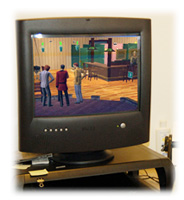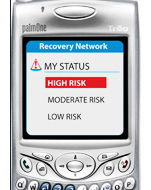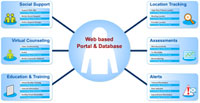How it works:
The IFR Recovery Network Prototype
This prototype is a creation of the "Addiction Treatment Vision Panel" funded by the Robert Wood Johnson Foundation. The initiative focused on identifying technology-based opportunities to improve outcomes and cost-effectiveness of the addiction treatment and recovery field. Contributors included people in recovery, caregivers, recognized leaders in the addiction treatment and recovery field as well as other experts from diverse fields such as informatics, artificial intelligence, genetics, pharmaceuticals, psychology and behavioral medicine.
Learn about the different services in the Innovations for Recovery prototype and how they work together to improve addiction treatment and recovery outcomes. View how the technologies work together from a technological and user standpoint. (Requires Flash Player)
Innovations for Recovery Model: A Synopsis
An Overview
According to the Substance Abuse and Mental Health Services Administration, there are nearly 20 million Americans in need of addiction treatment at any given time. Of these, only 25% have access to treatment and of those, half drop out. Of the half who complete treatment, as many as 90% relapse.
Although these facts are seemingly dismal, there is good news. Researchers from a new initiative called Innovations for Recovery (IFR) at the University of Wisconsin-Madison have been exploring ways technology can holistically and humanistically improve addiction treatment and recovery outcomes. The resulting relapse prevention model uses cost-effective, preexisting technologies to individually tailor treatment as needed and creates a social network of collaboration between people in recovery, their family/friends, and treatment professionals.
In the IFR model, people seeking treatment for addiction receive traditional services and certain practices are modified to integrate the IFR approach. Initially, patients undergo a comprehensive computer based assessment protocol to diagnose coexisting ailments and collect other treatment-facilitating data. As part of treatment services, individuals participate in virtual reality training to hone coping skills to learn refusal skills and how to identify triggers that may lead to relapse. Patients are also offered a discrete biomonitoring patch to track elevated levels of stress and trigger needed supports to proactively prevent a return to alcohol or drug use. While receiving treatment, patients and their support network are educated about the nature of addiction and elements that create successful, clean living through informative websites, online support groups, and in some instances, through computer animated counselors/avatars who offer engaging ways of delivering instruction.
Prior to completing intensive treatment, patients provide information on physical locations where they're most likely to suffer relapse (e.g., neighborhoods, bars, streets, etc.), generate lists of 'recovery-friendly' activities that match their interests, and provide names and contact information for their support group (e.g., friends, family, peer sponsors). In addition, patients are trained in the use of video cell phones and computers that will be used to deliver aftercare services to improve their likelihood of a successful recovery. For example, those in recovery may obtain information about nearby support meetings and social events and be notified if stress levels indicate an increased likelihood of relapse.
After intensive treatment is complete, persons in recovery are prompted by surveys on their mobile phones for ongoing assessment of their health status. Biomonitoring patches are constantly communicating with a central database and warn persons in recovery and their support groups when high levels of stress are detected. To help people in recovery reinvent themselves socially and recreationally, electronic cell phone and computer calendars are constantly updated and populated with descriptions of recovery-friendly activities; also, they're provided information about others in recovery who share similar interests so that they can extend their social network.
During recovery, people are encouraged to continue participation in online support groups, they're sent electronic reminders of scheduled appointments, and they may request on-demand counseling through video conferencing during times of crisis. Global cell phone positioning systems recognize when those in recovery enter locations where relapse is likely, and they and their support network are alerted on their mobile phones that additional help may be needed. Moreover, if the person in recovery is in a novel setting and in need of attending a meeting or seeing a counselor, he or she can electronically access the meeting and provider locator services for detailed information, directions, and contact information.
In summary, IFR has developed a comprehensive model that leverages preexisting technology as an intelligent solution for increasing access to treatment services and allows aftercare services to be offered as long as they are needed. Moreover, technology assisted recovery has the capability to make treatment more cost effective, bringing much needed efficiency to the field, offering individually tailored, user-centered treatment while also facilitating people-to-people interaction in the recovery process.
View an interactive model of how technologies work together to improve addiction treatment outcomes.
The Specifics
Assessment
Because 30 to 60 percent of substance abusers have concurrent mental health diagnoses, IFR uses Diagnosis and Planning to thoroughly diagnose substance abuse characteristics and related psychological problems. Easily accessible information generated from Diagnosis and Planning prepare the person in recovery and their family and friends to better understand the many challenges faced during recovery while simultaneously integrating the information into an individualized treatment plan.
 While in recovery, relapse is triggered by many factors. IFR advocates the use of wireless, handheld devices to deliver Mini Assessments to determine if any known risk factors are at levels that warrant further action. Such proactive monitoring, delivered via voice or text technology, can detect early warning signs and help the person to become aware of triggers as well as offer options for managing situations.
While in recovery, relapse is triggered by many factors. IFR advocates the use of wireless, handheld devices to deliver Mini Assessments to determine if any known risk factors are at levels that warrant further action. Such proactive monitoring, delivered via voice or text technology, can detect early warning signs and help the person to become aware of triggers as well as offer options for managing situations.
 Stress is the most accurate predictor of relapse. Therefore, by placing a discrete wireless patch on the person in recovery, autonomic nervous system activity may be monitored. If the patch senses heightened skin conductance, heart rate, pulse and increased muscle tension, the Biomonitoring patch communicates with a warning system, and the individual is notified by an automated message asking if he or she needs support. Also, the warning system may be programmed to notify that individual's support network. In addition to checking-in when clients are highly aroused, treatment providers can use biomonitoring data to crosscheck a client's calendar to objectively discuss routines or situations that may relate to negative arousal and increased likelihood of relapse (e.g., "I see that last Tuesday evening was especially stressful for you; do you want to discuss it?").
Stress is the most accurate predictor of relapse. Therefore, by placing a discrete wireless patch on the person in recovery, autonomic nervous system activity may be monitored. If the patch senses heightened skin conductance, heart rate, pulse and increased muscle tension, the Biomonitoring patch communicates with a warning system, and the individual is notified by an automated message asking if he or she needs support. Also, the warning system may be programmed to notify that individual's support network. In addition to checking-in when clients are highly aroused, treatment providers can use biomonitoring data to crosscheck a client's calendar to objectively discuss routines or situations that may relate to negative arousal and increased likelihood of relapse (e.g., "I see that last Tuesday evening was especially stressful for you; do you want to discuss it?").
Education & Training
Traditional educational methods can teach a person in addiction treatment about the temptations he or she will face when reintegrating with his or her social world. However, such learning is fairly far removed from the real-world experience and does not necessarily facilitate pragmatic problem solving or the ability to apply this knowledge to specific situations. There are several ways technology provides solutions.
 Virtual Reality Training using multiplayer video games where friends and family join the person in recovery in simulated environments allows the recovering addict to practice situations that may previously have lead to substance abuse. Today's video games offer players the ability to create and control characters that look similar to themselves and construct social environments similar to their own so they can practice a healthy, abstinent lifestyle that will sustain a lasting recovery.
Virtual Reality Training using multiplayer video games where friends and family join the person in recovery in simulated environments allows the recovering addict to practice situations that may previously have lead to substance abuse. Today's video games offer players the ability to create and control characters that look similar to themselves and construct social environments similar to their own so they can practice a healthy, abstinent lifestyle that will sustain a lasting recovery.
Many people with addiction problems get placed in "one size fits all" treatment based on their addictive substance, or they are placed in any program that is available and affordable. Rather than provide individuals generic information about addiction, technology makes it possible to personalize information for an individual in recovery so that they only receive information that is most relevant to their situation. Tailored information in the IFR system is facilitated by computer-based intake and assessments combined with an intelligently designed database that triggers information to people in recovery based on individual needs.
One particular challenge for those in recovery is learning how to reinvent oneself socially and recreationally. One way IFR supports persons in recovery is by sending the Healthy Event Newsletter containing information on positive social events and activities to the individual's phone or handheld device. Using wireless or synch technologies, people's calendars can be automatically filled in with events that are consistent with healthy activities that the individual in recovery has previously expressed an interest in. These technologies also have the capability to link users to other individuals in recovery who share similar interests to bring people together for companionship and support in activities likely to contribute to a lasting recovery.
Social Support
Self-help social support groups (such as 12-step meetings) have long been a staple of addiction treatment programs and are among the most commonly accessed component of recovery in the United States. Participation in support groups significantly reduces substance abuse and psychiatric problems. That said, typical face-to-face meetings are offered only at scheduled times, require transportation, and may or may not serve all attendees.
 Online Support Groups offer substantial benefits over face-to-face groups in that they are highly convenient, accessible anywhere there is access to the Internet and, if desired, preserve users' anonymity. These groups are most often structured as asynchronous text-based groups delivered via listservs or accessed on the Web, though some groups are also conducted via instant messaging or video conferencing.
Online Support Groups offer substantial benefits over face-to-face groups in that they are highly convenient, accessible anywhere there is access to the Internet and, if desired, preserve users' anonymity. These groups are most often structured as asynchronous text-based groups delivered via listservs or accessed on the Web, though some groups are also conducted via instant messaging or video conferencing.
In addition, a new class of technology called Mobile Social Software or "MoSoSo" offers geographical tracking via alpha-numeric text message phones and are especially well suited for newcomers to recovery who elect to be tracked on an opt-in basis. MoSoSo services such as Dodgeball allow users to "check in" indicating locations through text messages to a central server which redirects the information to pre-designated friends, family, and peer sponsors. The technology is helpful in identifying supportive others who are physically near the person in recovery so they can provide help when needed.
Educating family and friends about how to support a person in recovery while also attending to their own needs is an essential part of improving outcomes in addiction treatment. A Support Web Site offers online training for family and friends allows economical and on-demand services that traditional treatment cannot offer. Web-based training can serve to strengthen a family's ability to create a home environment that is supportive of recovery as family members learn how to eliminate enabling behaviors, change interactions that become relapse triggers, and respond to slips and relapses. It is also well known that addiction takes an emotional and psychological toll on family and friends. They may seek out organizations like Al-Anon who offer support for families and friends of people in recovery. In addition, many websites, like CaringBridge, allow patients the opportunity to create online journals to share success stories or setbacks, to post temptations or request assistance (e.g., rides to support meetings or after-care appointments, help creating a resume, etc.).
Virtual Counseling
Traditionally, face-to-face counseling is key ingredient in of addiction treatment. Although an important aspect for those in recovery, it's costly, requires transportation, and is scheduled around the therapist's availability and not necessarily the individual's schedule.
Technology again, offers cost-effective and immediate solutions. In the IFR model, Video Conferencing with professional counselors is offered through cell phones or computers. Similar to face-to-face counseling, therapy delivered by video conferencing provides visual cues, allowing for an intimate therapeutic experience. In addition, pre-packaged motivational speakers present a diverse range of thoughts and ideas than would likely be accessible in most communities.
![]() Making use of artificial intelligence through animated counselors - Avatars - is another way technology may increase access to services and streamline redundant processes so that the limited time spent between clients and their counselors is of the highest quality. Avatars respond intelligently to user questions and input with context-sensitive, spoken answers. Avatars' features like age, gender, hairstyle, skin tone, hair and eye color, and clothing can be individually determined. Avatars may provide routine information and collect data from patients with lower literacy skills and offer a more engaging way to deliver online education and support for people in recovery.
Making use of artificial intelligence through animated counselors - Avatars - is another way technology may increase access to services and streamline redundant processes so that the limited time spent between clients and their counselors is of the highest quality. Avatars respond intelligently to user questions and input with context-sensitive, spoken answers. Avatars' features like age, gender, hairstyle, skin tone, hair and eye color, and clothing can be individually determined. Avatars may provide routine information and collect data from patients with lower literacy skills and offer a more engaging way to deliver online education and support for people in recovery.
On-demand support through the Mobile Counselor Network provides people in recovery added assurance they can find counselors whenever they need no matter the physical location. By using Mobile Social Software and a cell phone, a person who requires immediate assistance can text message his/her primary counselor. If the counselor is unavailable, the message is broadcast to the mobile counselor network where other trusted and nearby professionals can provide the service.
Location Tracking
Global Positioning System (GPS) technology via cell phones offer services that far exceed traditional treatment. For example, when those in recovery elect to be monitored by GPS, they'll be warned when approaching an environment where relapse is more likely; with consent, the system may warn the individual's support group as well. Furthermore, GPS can be used to locate meetings or nearby providers in emergency situations.
Alerts and Reminders
 To reinforce long-term recovery, effective aftercare involves reminders about why one has quit, emphasizing the benefits of an abstinent lifestyle and providing tips for maintaining sobriety. Data are continually collected by providers and computer assessment about the person in recovery to trigger timely Tailored Reminders via text or audio messages via wireless handheld devices to reconnect patients to their recovery process before addictive thinking returns. Example alerts include reminders of significant milestones, inspirational messages or suggestions about local events conducive to clean living. Counselors, family and friends may also receive tailored messages relevant to their role as a supporter.
To reinforce long-term recovery, effective aftercare involves reminders about why one has quit, emphasizing the benefits of an abstinent lifestyle and providing tips for maintaining sobriety. Data are continually collected by providers and computer assessment about the person in recovery to trigger timely Tailored Reminders via text or audio messages via wireless handheld devices to reconnect patients to their recovery process before addictive thinking returns. Example alerts include reminders of significant milestones, inspirational messages or suggestions about local events conducive to clean living. Counselors, family and friends may also receive tailored messages relevant to their role as a supporter.
One of the greatest predictors of successful recovery is retention in treatment. However, many people in recovery do not reliably attend appointments -- a significant predictor for relapse. One simple solution is to deliver Appointment Reminders with text or voice messaging. Additionally, the alert can empower two-way communication to make it easy to call the provider back if the appointment needs to be rescheduled, for directions or to relay transportation problems.
The Risk Indicator service continually aggregates and analyzes multiple factors to predict the overall estimated risk level of relapse for a person in recovery. Using an algorithm combining data from known risk factors, the Risk Indicator integrates with the tailored alert system to automatically generate messages to the person in recovery and other relevant parties as needed to raise awareness and trigger whatever supports may be needed to reduce the risk of relapse.
 University of Wisconsin Madison
University of Wisconsin Madison